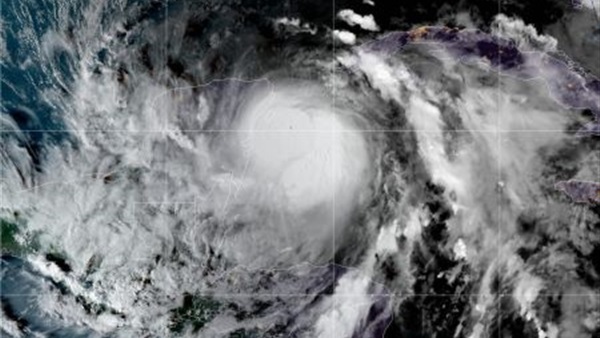Hurricane Zeta speeds toward a storm-weary Louisiana

Hurricane Zeta was speeding toward
storm-weary Louisiana and intensifying, with landfall expected as a Category 2
hurricane Wednesday afternoon. New Orleans, where a pump system failure has
raised flood risks, was squarely in its way.
Life-threatening storm surge and
strong winds were expected beginning around midday along the U.S. Gulf Coast,
where residents braced for the 27th named storm of a historically busy Atlantic
hurricane season.
Louisiana has had the worst of it,
hit by two tropical storms and two hurricanes. New Orleans has been in the
warning area for potential tropical cyclones seven times this year, each one
veering to the east or west.
“I don’t think we’re going to be as lucky with
this one,” city emergency director Collin Arnold said.
Zeta had been predicted to hit as
a relatively weak Category 1 hurricane, but Louisiana residents awoke to
updated forecasts predicting a Category 2, with top winds of nearly 100 mph
(160 kph) at landfall.
“The confidence is becoming very high that the
southeastern part of Louisiana and coastal Mississippi are going to see some
significant impacts from this storm,” said meteorologist Shawn O’Neil of the
National Weather Service in New Orleans.
“The good news for us -– and look, you take good
news where you can find it –- the storm’s forward speed is 17 mph. That’s
projected to increase, and so it’s going to get in and out of the area
relatively quickly, and then we’re going to be able to assess the damage more
quickly,” Gov. John Bel Edwards said in an interview on The Weather Channel.
While state and city officials
urged people to take precautions and prepare to shelter in place, there were
few signs of concern in New Orleans. Uptown, there were only a few boarded
windows, and it was business as usual in the French Quarter. “This one is
moving fast and I don’t think it’s going to do much,” said Kelly Ann, a visitor
from St. Petersburg, Florida, as she strolled Decatur Street.
Winds picked up and water rose above
the docks in Lafitte, a small community south of New Orleans that takes its
name from a French pirate. Workers drove truckloads of sandbags to low-lying
areas of the town, where thousands of sandbags already lined bayous and
roadways after previous storms this season.
New Orleans officials announced
that a turbine that generates power to the city’s aging drainage pump system
broke down on Sunday, with no quick repair in sight. There was enough power to
keep the pumps operating if needed, but little excess power to tap if other
turbines fail, officials said at a news conference with Mayor LaToya Cantrell.
Officials said they were running
through contingencies to provide power and make repairs where needed should
there be other equipment problems. Forecasts called for anywhere from 2 to 6
inches (5 to 15 centimeters) of rain to fall in the New Orleans area, but Zeta
is expected to be a relatively fast-moving storm, possibly mitigating the flood
threat.
Zeta raked across Mexico’s Yucatan
Peninsula Tuesday, toppling trees and briefly cutting power to more than
300,000 people but causing no deaths, before strengthening again along a path
slightly east of Hurricane Laura, which was blamed for at least 27 Louisiana
deaths after it struck in August, and Hurricane Delta, which exacerbated
Laura’s damage in the same area just weeks later.
Early Wednesday, Zeta’s top winds
grew to 90 mph (150 kph) and its forward movement increased to 17 mph (28 kph)
as its center moved north, about 265 mph (430 kph) south of the mouth of the
Mississippi River.
Hurricane warnings stretched from
Morgan City, Louisiana to the Alabama/Mississippi state line, including Lake
Pontchartrain and metropolitan New Orleans. Tropical storm warnings were in
effect for the western Florida Panhandle, forcing early-voting sites to close
for hours in three counties where Republicans dominate.
The center of Zeta should make
landfall in southeastern Louisiana in the afternoon, then move over Mississippi
in the evening before crossing the southeastern and eastern United States on
Thursday, the hurricane center said.
Edwards asked President Donald Trump
for a disaster declaration ahead of the storm. He and Alabama Gov. Kay Ivey
both declared emergencies, as did Mayor Andrew “FoFo” Gilich in Biloxi,
Mississippi. Trump declared an emergency for Louisiana Tuesday evening.
Zeta broke the previous record for
a 27th named Atlantic storm, taking shape more than a month before that one on
Nov. 29, 2005. It’s also this season’s 11th hurricane. An average season sees
six hurricanes and 12 named storms.
The extraordinarily busy hurricane
season has focused attention on the role of climate change, which scientists
say is causing wetter, stronger and more destructive storms.
With yet another storm
approaching, worries accumulated for people left homeless. The state is
sheltering about 3,600 evacuees from Laura and Delta, most in New Orleans area
hotels.
“I’m physically and mentally tired,” a
distraught Yolanda Lockett of Lake Charles said, standing outside a New Orleans
hotel.
Meanwhile, many along the coast
renewed an unwanted ritual of preparation.
In Louisiana’s coastal St. Bernard
Parish, east of New Orleans, Robert Campo readied his marina for another
onslaught. “We’re down for four or five days, that’s four or five days nobody’s
fishing. That’s four or five days nobody is shrimping. That’s four or five
days, no economic wheels are turning,” he said.
“I’ve never seen anything like
it,” said Thomas Hymel, an extension agent in Jeanerette with the LSU
Agricultural Center. He said the storms have meant more than a month of down
time for seafood harvesters, many of whom are already suffering a drop in
demand from restaurants due to the coronavirus pandemic.





